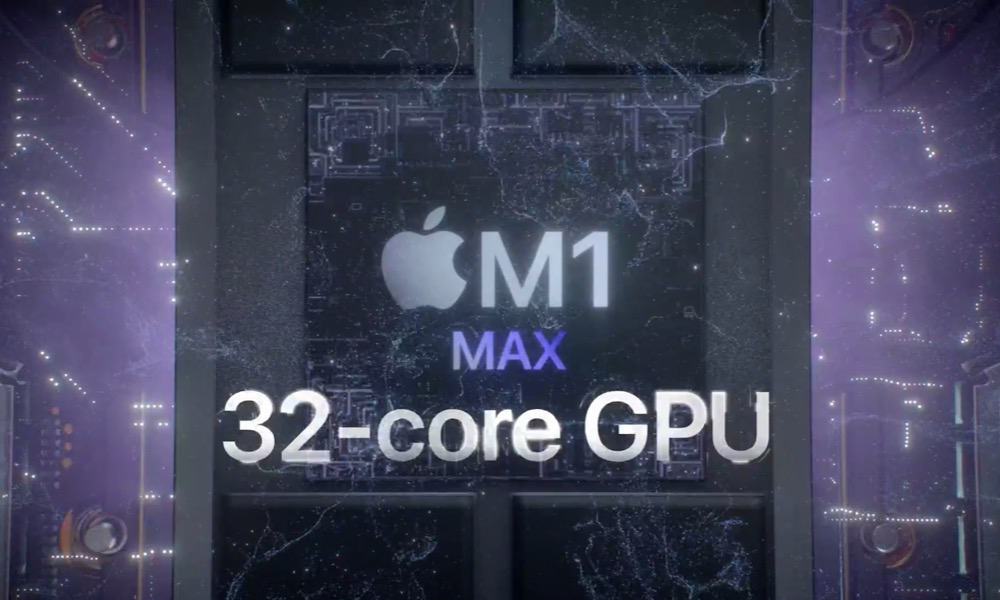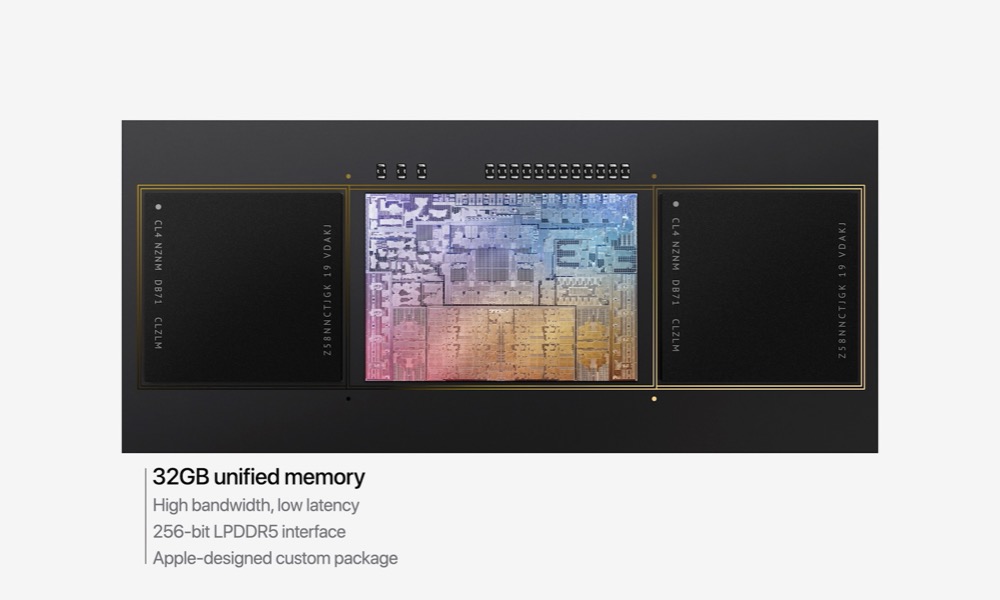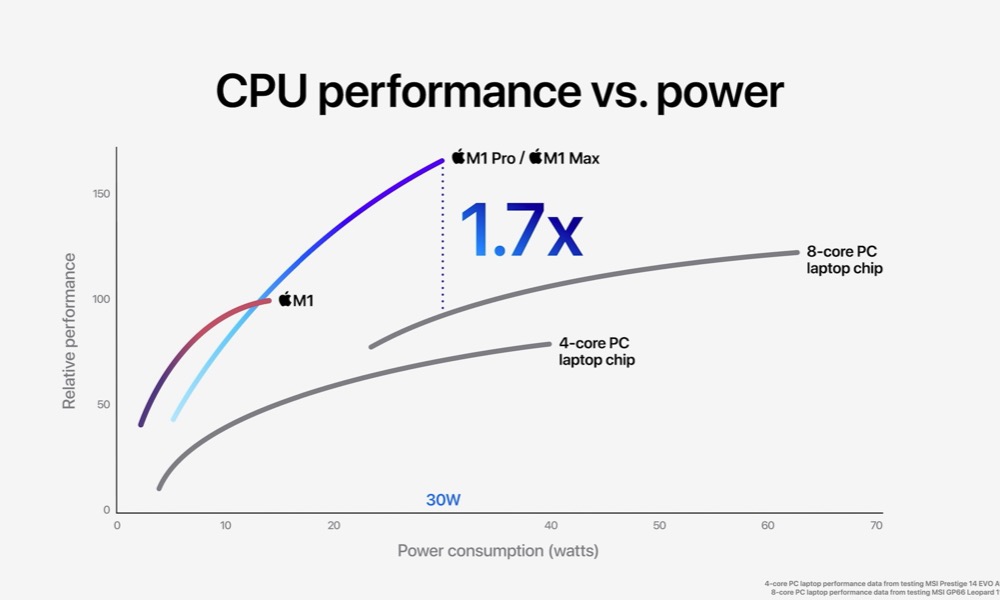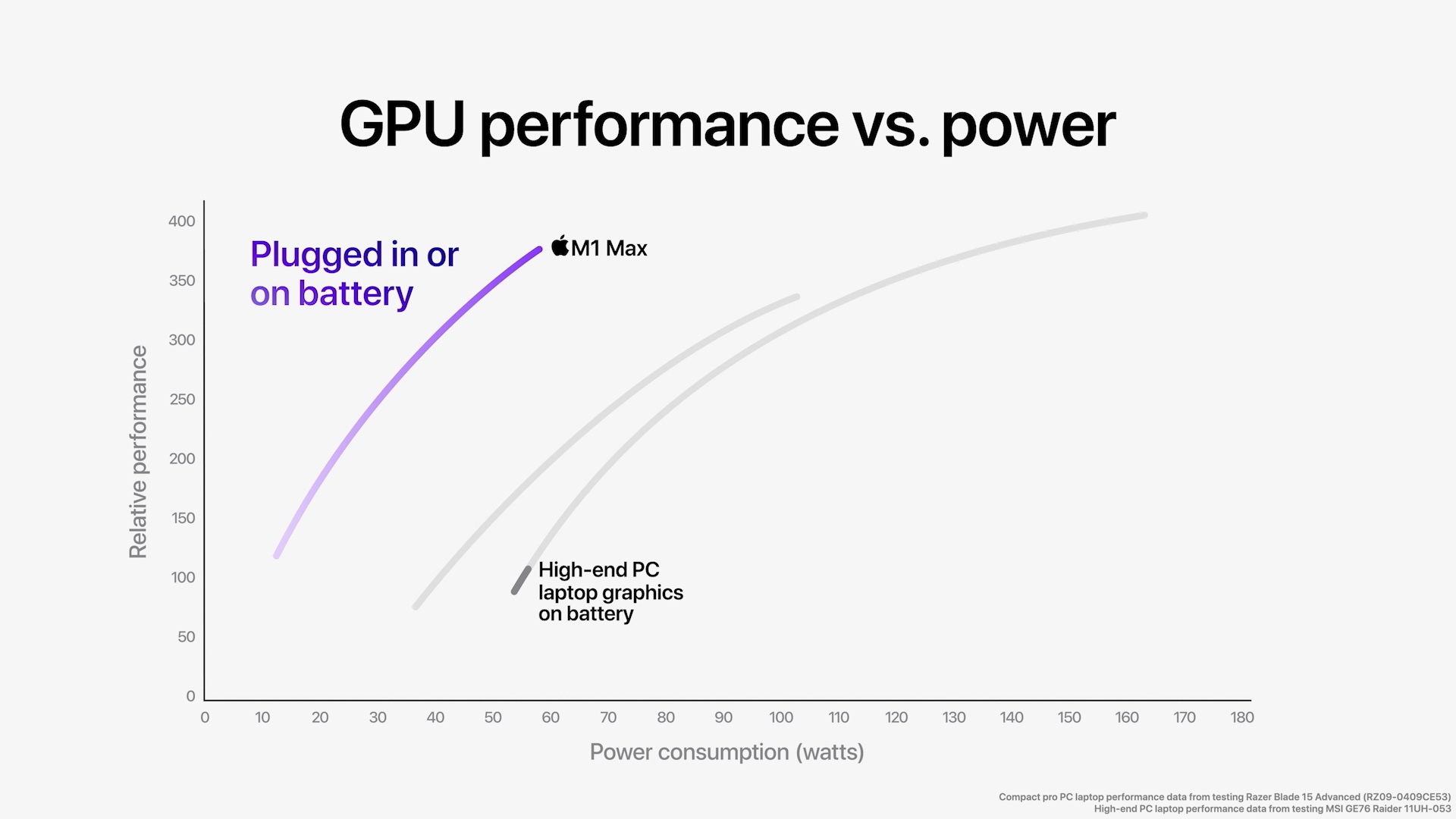Apple Unveils Groundbreaking New ‘M1 Pro’ and ‘M1 Max’ Chips | Power Like You’ve Never Seen Before
 Credit: Apple
Credit: Apple
Toggle Dark Mode
Today, Apple took the wraps off the “pro grade” versions of its M1 chips, surprising us with not a single “M1X” chip but rather two tiers of advanced Apple Silicon that push the performance envelope even further.
We’ve known for a long time that Apple had an upgraded version of the M1 in the works. Even before the earliest rumours of an “M1X” or “M2” came out, it seemed obvious from last year’s M1 Mac lineup that something bigger and better had to be coming. After all, despite the incredible power of the M1, Apple still left its highest-end Macs saddled with older Intel chips.
To be fair, there were some valid reasons for this that went beyond performance, including the need to support larger amounts of RAM, discrete graphics, and more displays and Thunderbolt ports — all things that the entry-level M1 couldn’t handle.
That all changes today, however, with Apple’s announcement of the new M1 Pro and M1 Max chips, which are designed to meet the varying needs of creative professionals and leave Intel’s Core i9 completely in the dust in every way.
The fact that Apple introduced a pair of new chips actually makes some sense, as we’ve heard rumours for a while that the so-called “M1X” would have had two different GPU core configurations. What nobody expected until very recently is that Apple would choose to differentiate them by name, rather than simply offering the same chip in multiple configurations, like Intel has done for years.
Hence, the M1 Pro and M1 Max, a pair of chips that share most things in common but differ in a few key areas.
The M1 Pro
Apple’s Senior VP of Hardware Technologies, Johny Srouji, took the stage to talk about the new M1 chips. Srouji has been the driving force behind all of Apple’s chip design efforts over the past decade or so, and it’s fair to say that it’s taken the company years of research and development under his leadership to get to this point.
Srouji made it clear that the M1 is still a great chip — and we’re definitely in agreement on that point — but the M1 Pro is designed for those users who need even more. Especially creative professionals who need to handle things like advanced video and photo editing.
As long rumoured, the M1 Pro companies the CPU and GPU into a two-chip architecture that unifies the memory between both components, much like the original M1 did for the CPU.
At a basic level, this allows much faster access to the memory, but in the case of the M1 Pro, the integrated GPU now means that there are no longer two separate pools of memory — and therefore no need to copy data back and forth between CPU and GPU memory.
As Srouji notes, this is the first time that anybody has ever created a system-on-a-chip with a discrete GPU, and most significantly this also means that it offers the most GPU memory ever available on a laptop computer, since it shares all the same system memory that’s available to the CPU.
Specifically, the M1 Pro will support up to 32GB of RAM, which means that the discrete GPU is also capable of 32GB of RAM — twice as much as the most powerful Intel laptop available today, which cap out at 16GB on typical discrete GPUs like the AMD Radeon.
Apple has also doubled the memory bandwidth inside the chip compared to the M1, which already offered blazingly fast memory access speeds. In the case of the M1 Pro, however, that moves up to 200GB/s of memory bandwidth, or about three times faster than the M1.
Naturally, the M1 Pro uses the same 5nm fabrication technology as Apple’s other recent chips, including the M1 and the A15, but the larger size also means that Apple has managed to pack on twice as many transistors as the M1 — around 33.7 billion.
This equates to a 10-core CPU, with eight high-performance cores and two high-efficiency cores, which gives it 70% faster CPU performance than the M1.
Where the M1 Pro really shines, however, is with the 16-core GPU, which delivers 2x faster graphics performance over the M1, and includes a Media Engine that can handle decoding and encoding of both standard video formats such as H.264, HEVC, and professional video formats like ProRes and ProRes RAW.
In fact, the M1 Pro has many of the features of the Mac Pro’s Afterburner card built right in, and can accelerate ProRes content to the point where users can edit multiple streams of 4K and 8K video with just a fraction of the power consumption of an Intel MacBook Pro.
The display engine has also been beefed up, offering support for up to two external Apple Pro Display XDRs via the Thunderbolt 4 bus, along with additional Thunderbolt I/O controllers.
The M1 Max
The M1 Max is essentially an advanced version of the M1 Pro that doubles the graphics and memory specs.
In terms of pure CPU performance, the M1 Max is identical to the M1 Pro. Both chips feature a 10-core GPU, with eight high-performance and two high-efficiency cores. Srouji offered no indication that the individual cores are any different between the two chips. In fact, he hinted that the cores are the same as those found in the M1 — there just happen to be more of them overall, and more dedicated to performance than efficiency.
For instance, the M1 has four high-performance and four high-efficiency cores, for a total of eight, but in reality the M1 Pro and M1 Max are significantly faster because they double the number of high-performance cores to eight, while cutting the high-efficiency cores in half.
After all, these are chips that are designed primarily for powerful workflows rather than surfing the web and checking your email, so high-efficiency cores are considerably less important.
Where the M1 Max differs is that it doubles the GPU cores to 32, giving it four times the graphics performance of the M1. With this also comes support for up to four external displays, plus two video encoding engines, and two more ProRes encode/decode engines.
The memory interface has also been doubled, supporting up to 64GB RAM and a 400GB/s memory bandwidth. That’s twice the bandwidth of the M1 Pro, and six times that of the M1.
Like the M1 Pro, the 64GB of memory is unified, meaning that the M1 Max can deliver an unprecedented 64GB of high-speed graphics memory to the 32 GPU cores.
M1 Pro, M1 Max Energy Efficiency
As with the M1 chip, the M1 Pro and M1 Max are all about delivering as much performance as they can as efficiently as possible.
Srouji notes that the new chips deliver industry-leading performance per watt, and in fact they’re able to run so efficiently that they can deliver the same performance for a MacBook running on battery as they do when it’s plugged in.
By comparison, most high-end Intel laptops with powerful Core i9 CPUs and discrete GPUs only deliver their best performance when using external power, to avoid draining the battery too quickly. The M1 Pro and M1 Max chips, however, continue to run at full performance regardless of the power source.
In practical terms, this means that the M1 Max can deliver the equivalent performance to the fastest PC laptop GPU while using up to 40%, or 100W, less power, and that’s only when the PC laptop is plugged in. Run that same PC laptop on battery, and the M1 Max will run circles around it, performing up to three times faster.
Of course, the gains are even higher if you compare the M1 Pro against a PC laptop with integrated graphics, rather than a discrete GPU, at which point the M1 Pro chip comes in at seven times faster.
However, the name of the game for Apple here was more about power efficiency than raw performance, as Srouji admitted that even the M1 Max doesn’t offer any huge performance gains over the top-end PC laptop discrete GPUs, but what’s important is that it does it with 70% less power, and therefore less heat, and less resulting fan noise.
This is important not just for things like battery life, either. Cooler chips can run sustained workloads for far longer, as they won’t need to worry about thermal throttling, and of course, they’ll also last longer overall.












